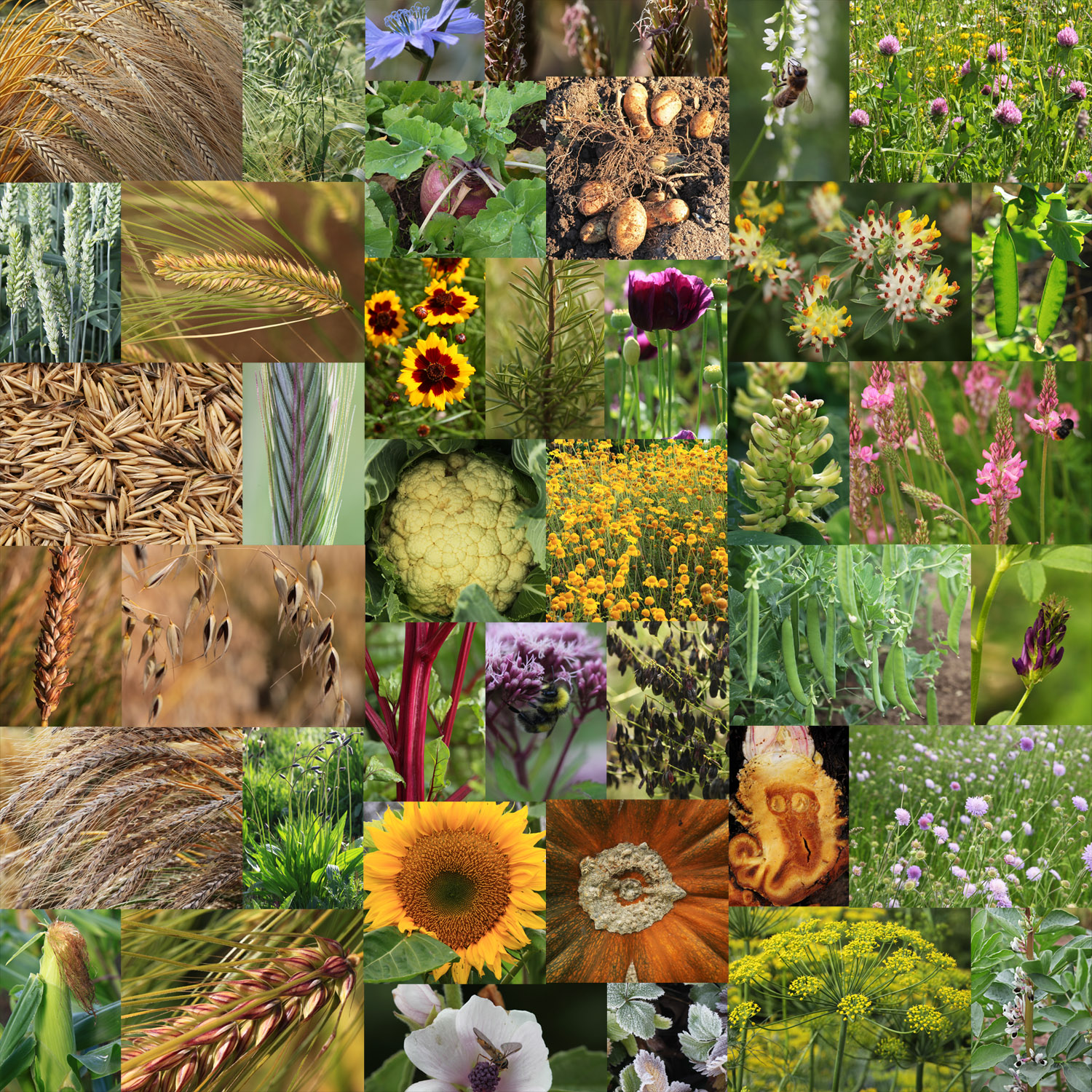The Living Field has been studying and promoting the diversity of crops and cropping methods since its beginning over 15 years ago. The Garden displays the different crops grown since the first farmers arrived here thousands of years ago.
The Garden’s habitats also harbour and attract a range of wild plants that have themselves been nurtured and harvested in the wider landscape.
Why diversification? Many of our crops have been lost in the march to uniformity and many wild plants are threatened by loss of habitat. Plant diversity in the croplands has decreased in the last 150 years.
Yet there is a drive to reclaim this heritage, to diversify agricultural fields and landscapes for the betterment of the environment and human nutrition.
The collage above shows some of the crops and other useful plants grown in the Living Field garden in recent years. The cereals are towards the left and the legumes to the right, while the centre holds dyes, medicinals, vegetables and ‘root’ crops. [Click on the image and a larger copy will appear in a new tab.]
What does crop diversity do?
Each type of plant uses the resources of sunlight, water and nutrients to form its body, including the things we take off it as yield – grain, leaf, root and so on. Each type takes up, uses and passes on these resources in slightly different ways. They open or close channels through which the resources flow – some to us in the form of nutritious food, some to the soil and some to food webs and wildlife.
A single type of plant can open only a small number of channels – it blocks the others off. Therefore many types need to be grown together to ensure that all the channels necessary for the ecological wellbeing of the land are open and working.
Therefore as plant diversity declines, channels are closed and the ecosystem malfunctions. An example is the decline of legume crops and wild plants such as peas, beans, vetches and clovers. They fix their own nitrogen (an essential plant nutrient) and so do not need to be given mineral nitrogen fertiliser (which, apart from helping plants to grow, can be a damaging pollutant).
Is crop diversity declining?
There has been a trend in the last 150 years to reduce the diversity in crops and grass which have together sustained people here since the neolithic age 5000-6000 years ago. The changes have not been abrupt, but they accelerated after the 1950s due to the higher yields that were achievable using mineral fertiliser and pesticide.
Barley is now dominant, whereas many other types have declined or disappeared. The tuber crops such as turnips, swedes and potatoes, the legumes such as peas, beans and vetches, and the dyes and fibres have all declined in area in the last 150 years. Some such as the fibre crop, flax, or the dye plant, woad, are no longer grown.
Along with increasing use of pesticide, these changes have limited the channels through which natural resources flow to sustain the ecosystem. They have reduced farmland wildlife and in some cases endangered the capacity of soil to sustain life.
But while food security was assured in the 1960s, perhaps for the first time ever, agriculture then became geared to the manufacture of drink and animal feed, while the people living here came to rely on imports for food.
The croplands are out of balance!
Can diversity be restored?
There are increasing and welcome pressures to re-diversify agricultural land for the benefit of all forms of life that rely on it. The pressure certainly comes from many small enterprises and businesses involved in creating a sustainable and healthier food system, but pressure also comes through European Union influence.
Notably, funding from the EU has enabled researchers at the Hutton to collaborate and share knowledge and practice of diversification with scientists and innovators throughout Europe.
A series of short articles is therefore planned for the Living Field web site, covering:
- the origins and decline of diversity in crops and their associated plants and animals;
- the ‘channels’ by which crops and their management regulate the flows of energy and matter through the ecosystem;
- the methods that can be used to restore and maintain diversity in the field and landscape.
Putting knowledge into practice on the farm
The James Hutton Institute’s farms and science have been re-diversifying agriculture for some years. There’s a range of projects on mixed cropping including undersowings, practices to conserve and build soil and landscape ‘engineering’ to improve the habitats and encourage movement of wildlife.
The Living Field garden will continue to grow and display many of the crops and useful wild plants that sustained people here since the last ice.
Author/contact: geoff.squire@hutton.ac.uk

